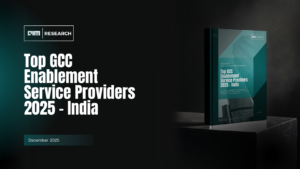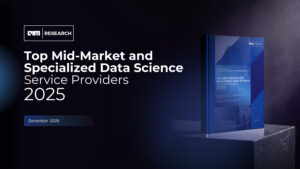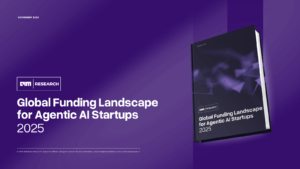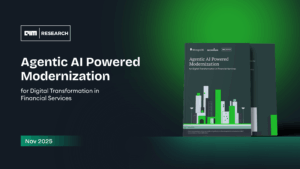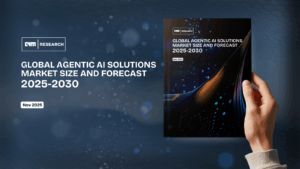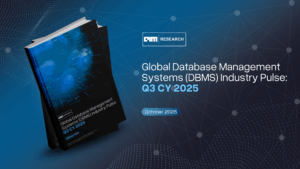

The report ‘The State of Trending AI Technologies 2025 – Data and AI Signals, Trends, and Predictions for Enterprises in 2025’ provides enterprises with the knowledge needed to navigate the AI-driven future. Understanding these trends and their implications is crucial for making informed decisions in an increasingly AI-augmented business landscape.
The state of AI technologies in 2025 reflects a period of unprecedented change, where the pace of innovation is outstripping many organizations’ ability to adapt. As we move through this pivotal year, the key to success lies not in perfectly executing long-term plans, but in building the organizational capability to continuously evolve alongside technological advancement. The transformative vision many organizations had for 2030 is already being realized in 2025, forcing a fundamental rethink of how enterprises approach technological innovation and implementation.
As we progress through 2025, it’s becoming clear that the technological roadmaps created in the immediate post-pandemic period may have underestimated the pace of AI advancement. Organizations must now navigate a landscape where:

The traditional SaaS model is undergoing a fundamental transformation where AI workers become autonomous actors rather than mere tools. This shift is driving new pricing models based on outcomes rather than licenses, fundamentally changing how software services are delivered and consumed.
AI integration into daily devices has become ubiquitous, creating an ecosystem of smart, context-aware technologies that seamlessly interact with users across home, health, and personal productivity domains. This widespread adoption is driven by advances in edge computing and specialized AI hardware.
A new paradigm has emerged where AI-generated code coexists harmoniously with legacy systems. This evolution enables rapid innovation while preserving valuable existing business logic, creating a hybrid environment that maximizes both efficiency and reliability.
The traditional data analytics field is experiencing a significant shift as basic data processing becomes automated. Professionals are now required to possess advanced skills in machine learning and generative AI, marking a transition from descriptive to predictive and prescriptive analytics.
Generative AI has moved beyond experimental phases to become a practical tool delivering measurable business impact. Organizations are now focusing on enterprise-wide integration rather than isolated proof-of-concepts, marking a maturity milestone in AI adoption.
Healthcare systems are leveraging AI to combat clinician burnout through intelligent automation of routine tasks. This integration is transforming patient care delivery while optimizing healthcare provider workflows and decision-making processes.
The barriers to AI adoption have significantly lowered, enabling non-technical users to develop and deploy AI solutions. This democratization is driving innovation across industries and creating new opportunities for businesses of all sizes.
Organizations are prioritizing cost-efficient AI deployments through optimized infrastructure and resource utilization. This focus on cost management is driving innovations in model efficiency and deployment strategies.
While computing power continues to scale, data remains the primary bottleneck in AI advancement. Organizations are focusing on developing specialized systems with contextually relevant datasets rather than relying solely on general-purpose models.
The humanoid robotics market is experiencing significant growth, with applications expanding across healthcare, customer service, and personal assistance. This progression marks a new era in human-robot interaction and automation.
Organizations are grappling with exponential growth in data volume from IoT devices, driving the adoption of edge computing solutions for real-time analysis and actionable insights generation.
Small and medium enterprises are increasingly embracing AI through affordable, pre-trained models and accessible tools, democratizing access to advanced AI capabilities across the business spectrum.
Customer experience has evolved to predictive personalization, utilizing real-time multimodal data analysis to deliver dynamic, context-aware experiences at unprecedented scale and precision.
Data centers are facing mounting pressure to balance AI’s growing energy requirements with environmental sustainability, spurking innovative approaches to energy-efficient computing.
Traditional dashboard-based analytics are being replaced by GenAI-powered self-service platforms that provide prescriptive insights, though data quality remains a critical concern requiring robust guardrails.
Current State: Moving from prototype experiments to market introductions, with major tech players and startups collaborating to expand autonomous agent capabilities. The ecosystem is actively preparing to embrace this technology through fostering innovation.
Predicted Impact in 2025: We’re seeing the emergence of virtual assistants with greater autonomy (though not full autonomy). The technology is rapidly advancing in maturity, with software systems becoming increasingly context-aware and capable of executing complex, multi-step tasks with minimal human intervention. This marks a significant shift from traditional SaaS to a Service as Software model.
Current State: These models are distinguished by their “thinking time” approach, taking longer to respond while working through problems systematically. While showing remarkable performance improvements, challenges remain in logic handling, security, and comprehensive evaluation frameworks.
Predicted Impact in 2025: Focus is shifting toward integrating these models into business applications for complex decision-making, developing hybrid systems with domain-specific modules, and improving self-verification and error correction capabilities. The balance between speed and accuracy in real-world applications remains a key consideration.
Current State: Major tech companies are pushing boundaries with multimodal large language models. The technology is transitioning from experimentation to market introduction, with companies like Amazon planning launches in mid-2025 and OpenAI introducing advanced voice features with vision capabilities.
Predicted Impact in 2025: Progress in this area is crucial for creating more human-like systems capable of assisting in critical areas requiring quick, informed decisions based on multiple inputs in unpredictable situations. This represents a significant step toward machines that perceive and understand the world more like humans do.
Current State: Organizations are moving beyond experimentation and beginning to integrate LLM-powered GenAI applications into production. The market is crowded with both large players and startups offering tools for logs & analytics, evaluation, observability, security guardrails, and cost optimization.
Predicted Impact in 2025: The trend is moving toward unified platforms to reduce tool sprawl and deliver seamless user experiences. We can expect increased M&A activity in this space as large players acquire startups offering specialized GenAI-specific tools.
Current State: The landscape is dominated by intense competition among tech giants for AI chip acquisition and development. Orders have more than doubled compared to 2023, with companies either developing custom in-house AI chips or entering the chip market to compete directly.
Predicted Impact in 2025: While Nvidia maintains market dominance, it faces increasing challenges from companies developing custom AI chips. The AI technology stack is opening numerous opportunities for semiconductor and AI Hardware companies, with rising demand for advanced materials across AI, Edge AI, and Data Center applications.
Current State: There’s growing recognition of the need for a portfolio approach, combining small and large models for specific scenarios. Companies are realizing that general-purpose LLMs with billions of parameters aren’t always necessary for specific tasks.
Predicted Impact in 2025: Expect increased quantization of small models and new launches throughout 2025, particularly for edge computing and vertical-specific applications. These models are proving especially valuable for regulated industries and scenarios requiring high-quality results with on-premises data processing.
Current State: Major cybersecurity solution providers have added AI capability layers to existing solutions or are developing AI-native architectures. The emergence of GenAI has led to increased integration of Generative AI-specific capabilities into cybersecurity tools.
Predicted Impact in 2025: While full autonomy isn’t expected, major developments are occurring in automation, predictive threat intelligence, and alert prioritization. Organizations are increasingly using these tools to augment early- to mid-level cybersecurity professionals, addressing workforce gaps and skill shortages.
Current State: While over 1,000 AI/ML-enabled medical devices exist, AI-driven drug discovery is just beginning to see real-world application success. The FDA’s acceptance of its first AI algorithm as a drug development tool marks a significant milestone.
Predicted Impact in 2025: The field is expected to see increased collaboration within the ecosystem, with a focus on real-world data over synthetic data for AI training. Hybrid trials are becoming the new norm, with AI transforming trial design, patient recruitment, and precision medicine.
Current State: The field has experienced a renaissance powered by efficient AI models and specialized hardware from companies like Qualcomm, MediaTek, and Apple. The emergence of compressed foundation models has enabled sophisticated AI to run locally.
Predicted Impact in 2025: More smart devices will leverage edge AI for automation and security, reducing cloud dependency while improving privacy. Enhanced real-time processing for safety-critical decisions will become standard, with selective cloud communication for non-urgent data.
Current State: The race to develop humanoid robots has made significant strides, led by tech companies from the US and China. These robots are being developed for tasks ranging from home assistance to patient care and manual labor.
Predicted Impact in 2025: 2025 will see limited production of humanoid robots for entertainment, companionship, factory tasks, and customer service. This marks the beginning of a transformative shift as humanoid robots gradually take on more complex roles across industries and households.
As we look toward the future, the question is no longer whether enterprises will adopt these technologies but how quickly and effectively they can integrate them into their core functions. The transformative potential of emerging AI technologies promises a future of unprecedented innovation, but only those prepared to adapt will reap the rewards.
Check the complete report here: Annual Report – State of Trending Technologies
$0.00
